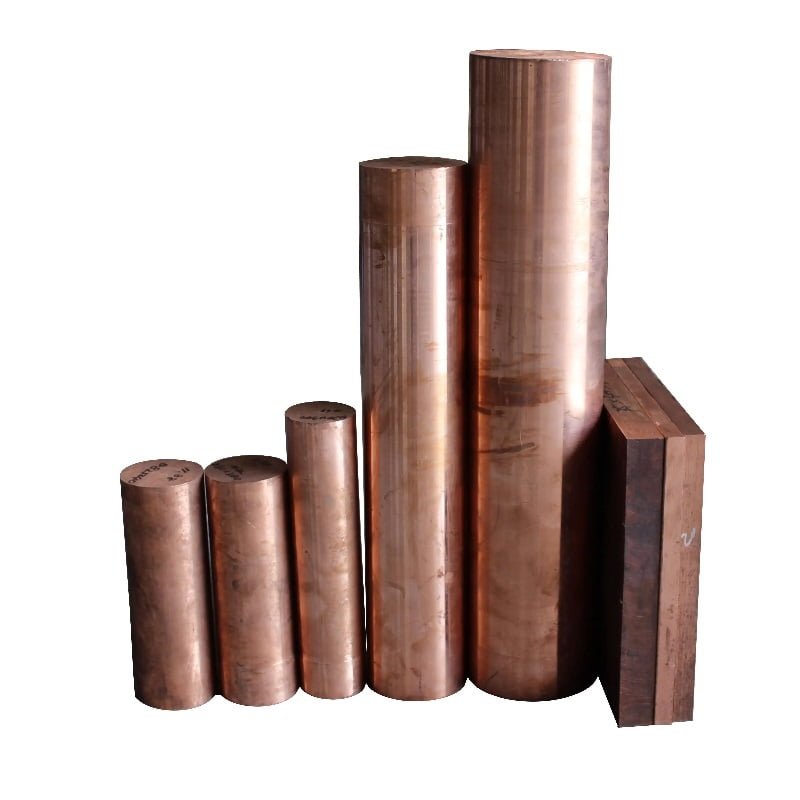
C18150 and C18200 are both copper-chromium-zirconium alloys, commonly used in industrial applications where high strength, electrical conductivity, and resistance to corrosion are crucial. While they share similarities due to their alloy composition, there are important differences between C18150 and C18200 that influence their specific applications and performance characteristics.
Alloy Composition
- Copper (Cu): Approximately 97.5% min
- Chromium (Cr): 0.50-1.50%
- Zirconium (Zr): 0.10-0.50%
- Other Elements: Small amounts of other elements like iron (Fe) and phosphorus (P) may be present.
C18200:
- Copper (Cu): Approximately 96.0% min
- Chromium (Cr): 1.20-2.00%
- Zirconium (Zr): 0.10-0.60%
- Other Elements: Small amounts of other elements like iron (Fe) and phosphorus (P) may be present.
Key Differences
1. Chromium Content:
- C18150: Contains 0.50-1.50% chromium.
- C18200: Contains 1.20-2.00% chromium.
The higher chromium content in C18200 (compared to C18150) generally provides increased strength and hardness, as well as improved resistance to corrosion and wear. This makes C18200 suitable for applications where higher mechanical properties and better corrosion resistance are required.
2. Electrical Conductivity:
- C18150: Typically has slightly higher electrical conductivity compared to C18200 due to its lower chromium content. This makes C18150 suitable for applications where high electrical conductivity is critical, such as in electrical contacts and conductive components.
3. Mechanical Properties:
- C18200: With its higher chromium content, C18200 tends to have higher strength and hardness compared to C18150. This makes C18200 more suitable for applications requiring good mechanical properties, such as in welding electrodes, resistance welding components, and mold inserts.
4. Thermal Conductivity:
- Both alloys have good thermal conductivity, which is a typical characteristic of copper alloys. The addition of chromium and zirconium does not significantly affect thermal conductivity compared to pure copper, making these alloys suitable for applications requiring efficient heat transfer.
Applications
C18150:
- Electrical Contacts: Due to its high electrical conductivity and good resistance to softening at elevated temperatures, C18150 is commonly used in electrical contacts, connectors, and terminals.
- Welding Electrodes: Its excellent resistance to heat and wear makes C18150 suitable for welding electrodes and other resistance welding components.
- Mold Inserts: In injection molding applications, C18150 is used for mold inserts where good thermal conductivity and wear resistance are required.
C18200:
- Resistance Welding Components: Its higher strength and hardness make C18200 ideal for resistance welding components, electrodes, and tips.
- Plastic Molding: C18200 is used in plastic injection molds where its hardness and resistance to wear are beneficial.
- Heat Exchanger Plates: Its corrosion resistance and thermal conductivity make C18200 suitable for heat exchanger plates and fins.
Performance Characteristics
- Corrosion Resistance: Both C18150 and C18200 exhibit good resistance to corrosion, which is essential for their use in various industrial environments.
- Machinability: Copper-chromium-zirconium alloys are generally machinable, allowing for the fabrication of complex shapes and components.
- Weldability: These alloys can be welded using standard welding techniques suitable for copper alloys.
Conclusion
In conclusion, while C18150 and C18200 are both copper-chromium-zirconium alloys used in similar industrial applications, their specific compositions and properties make them suitable for different types of applications. C18200, with its higher chromium content, offers superior strength and hardness compared to C18150, which has slightly higher electrical conductivity. The choice between these alloys depends on the specific requirements of the application, such as mechanical strength, electrical conductivity, corrosion resistance, and thermal properties. Understanding these differences allows engineers and designers to select the most appropriate alloy for optimal performance and longevity in their respective applications.
